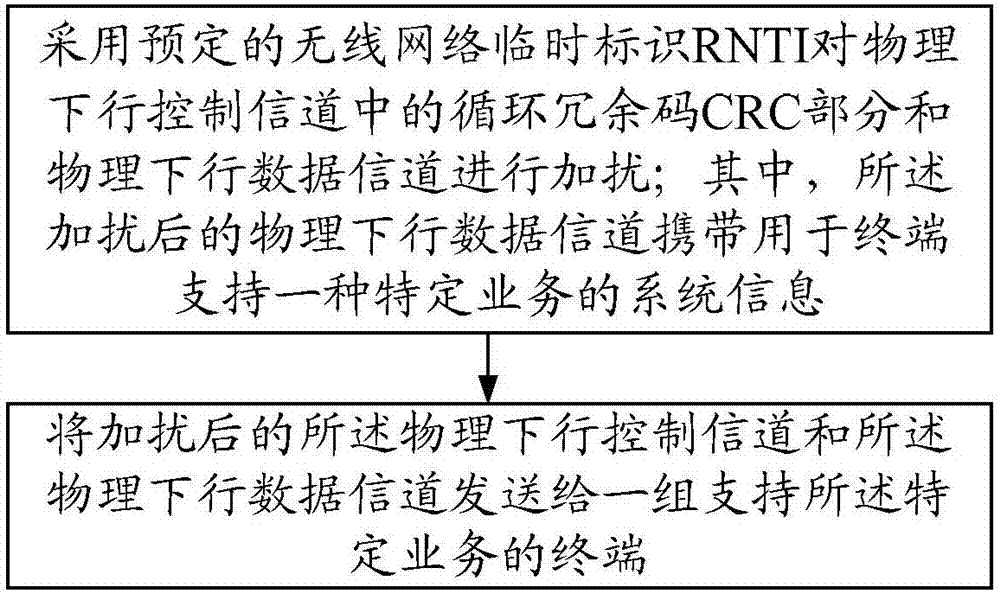Communication method and communication device for downlink control information
A technology for control information and physical downlink control, applied in the field of LTE and NR mobile communication networks, and can solve problems such as low information transmission efficiency
- Summary
- Abstract
- Description
- Claims
- Application Information
AI Technical Summary
Problems solved by technology
Method used
Image
Examples
Embodiment 1
[0161] As shown in Table 3, according to the current situation of supporting short TTI terminal access, when multiple sets of PRB pairs need to be used, the positions of multiple sets of PRB pairs need to be sent in the PDCCH, and when both uplink and downlink need to configure multiple sets of PRB For example, four sets of PRB pairs are used for channel allocation of the downlink sPDSCH channel and uplink sPUSCH channel. At this time, it is not appropriate to use the PDCCH channel to configure related public resources. Therefore, a new RRC message is introduced to send these public radio resource configuration information. This new RRC message is sent on the PDSCH channel, and is scrambled with a scrambling code different from SI-RNTI, such as STTI-RNTI shown in Table 3. STTI-RNTI is a group RNTI that supports short TTI for a group shared terminal.
[0162] table 3
[0163]
Embodiment 2
[0165] When a D2D-supporting terminal accesses the base station, the base station determines whether to send updated system information for D2D communication to a group of D2D-supporting terminals using D2D-RNTI scrambled physical downlink data channels. When there is no D2D terminal access in a cell under a base station supporting D2D, the base station does not need to send system information for D2D communication of the D2D terminal. Or when all the terminals supporting D2D communication in the cell have released the wireless link, the base station does not need to send system information for D2D communication to the D2D terminals in the cell. As the D2D-RNTI shown in Table 4, the D2D-RNTI is a group RNTI shared by a group of terminals supporting D2D communication.
[0166]
Embodiment 3
[0168] Image 6 A schematic diagram of sending a PDCCH and PDSCH scrambled by an STTI-RNTI scrambled by a terminal supporting a short TTI is given in a specific subframe. Image 6 The discontinuous reception period of the middle terminal is 10 subframes, and 3 subframes need to detect whether there is an STTI-RNTI scrambled PDCCH control channel, and the offset of the start subframe within a system frame is 0. In subframes k, k+1 and k+2, the terminal needs to detect whether the base station uses the STTI-RNTI to scramble the PDCCH and PDSCH in these subframes, and sends public radio resource configuration information. Similarly, in subframes k+10, k+11, k+12, k+20, k+21, k+22 and k+30, k+31, k+32 terminals also need to do related detection, as shown in Fig. For other positions given in , the terminal does not need to detect whether there is a PDCCH control channel scrambled by STTI-RNTI, which is used to reduce power consumption. Image 6 There are 3 subframes in each disco...
PUM
 Login to View More
Login to View More Abstract
Description
Claims
Application Information
 Login to View More
Login to View More - R&D
- Intellectual Property
- Life Sciences
- Materials
- Tech Scout
- Unparalleled Data Quality
- Higher Quality Content
- 60% Fewer Hallucinations
Browse by: Latest US Patents, China's latest patents, Technical Efficacy Thesaurus, Application Domain, Technology Topic, Popular Technical Reports.
© 2025 PatSnap. All rights reserved.Legal|Privacy policy|Modern Slavery Act Transparency Statement|Sitemap|About US| Contact US: help@patsnap.com



